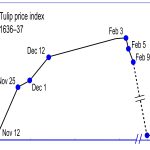Every time I read about this event I still can’t comprehend it, the Tulip bulbs boom of 1620 is certainly an event that should be taught to all economic students in how blind speculation can lead a nation to near economic ruin. Before you read on I remind you that this is not a fictional tale but a true story, where, in Holland, the humble tulip bulb soared in popularity & price leading to the first economic bubble ever recorded with prices of bulbs rising to extraordinary levels before collapsing again without any warning
- Tulip bulb
- Tulip bulb
- Tulip bulb
To this day the Dutch are renowned for their Tulip & flower industry and they supply bulb fresh tulip bulbs & cut flowers all across Europe. The tulip however is not native to Holland, in fact they originate from Central Asia. In the early 1600’s Tulips were first brought to the Netherlands & they soon became a favorite of botanists who were intrigued by there array of vibrant petal colours. But this interest in Tulip Bulbs was only among growers & horticulturists until the occurrence of Tulip breaking. Tulip breaking was then, a strange phenomenon which lead to Tulips developing multicolored, striped petals. With Tulip breaking & the work of botanist to develop an endless array of new & exciting new cultivars, the popularity in these bulbs began to grow. At first new & exciting varieties were traded & exchanged between botanists only, but eventually interest was sparked within the general public & soon Tulip bulbs were becoming a trendy commodity to own. This saw Tulips being exchanged for money & not before long Tulip brokerages began to pop up buying & selling the bulbs
The Tulip Bulbs Bubble
A number of elements combined which lead to the first ever economic bubble. The first was money, at this time The Netherlands was becoming the richest country in Europe, The middle classes were becoming more affluent & had disposable cash for the first time. Another element was the recent introduction of the Netherlands Stock Market which became the platform for the bulbs sales & rise in value. The third element was the growers and their efforts to develop new extravagant Tulip cultivars. These exciting flowers created a hype throughout the country as shopkeepers, neighbours, teachers & students all discussed & compared tulips. This hype lead to a surge in demand & sparked the initial sharp increase in prices.
Stories of these price increases are difficult to comprehend, even after more recent economic bubbles. But, by the 1620’s it is reported that a Dutch townhouse was offered in exchange of just 10 bulbs. Whats more incredible is that the offer was turned down. The cultivar on offer was Semper Augustus. By 1633 one bulbs was worth 5000 guilders, by 1637 one bulbs was worth 10,000 guilders. In today’s money 10,000 guilders equates to approx. 150530€. Incredible prices increases but no doubt, when your in the middle of it & the prices just seem to rise & rise it is plausible that people would continue to invest & speculate heavily in the market. Invest they did, with much of the country caught up in the craze everyone in the Netherlands was at serious risk if the market collapsed
The Tulip Bulb Collapse
As we all now know, every bubble will eventually burst. By the end of the 1636 the market completely collasped. People were no longer willing to pay the ludicrously high prices leading to a price fall, quickly falling to a tenth of their value. This lead to a financial crisis that not even the government to step in to resolve. Payment disputes went on for many years, Shop keepers, cobbles, carpenters, teachers were in financial ruin. Even the smart speculators who managed to get out early still suffered from the impending recession that followed
The strange phenomenon, Tulip breaking was in fact caused by a virus. Sadly many of these cultivars that rose to fame during the Tulip boom are no longer available, these include
- Tulip Viceroy
- Tulip Admirael van Enchuysen
- Tulip Semper Augustus


